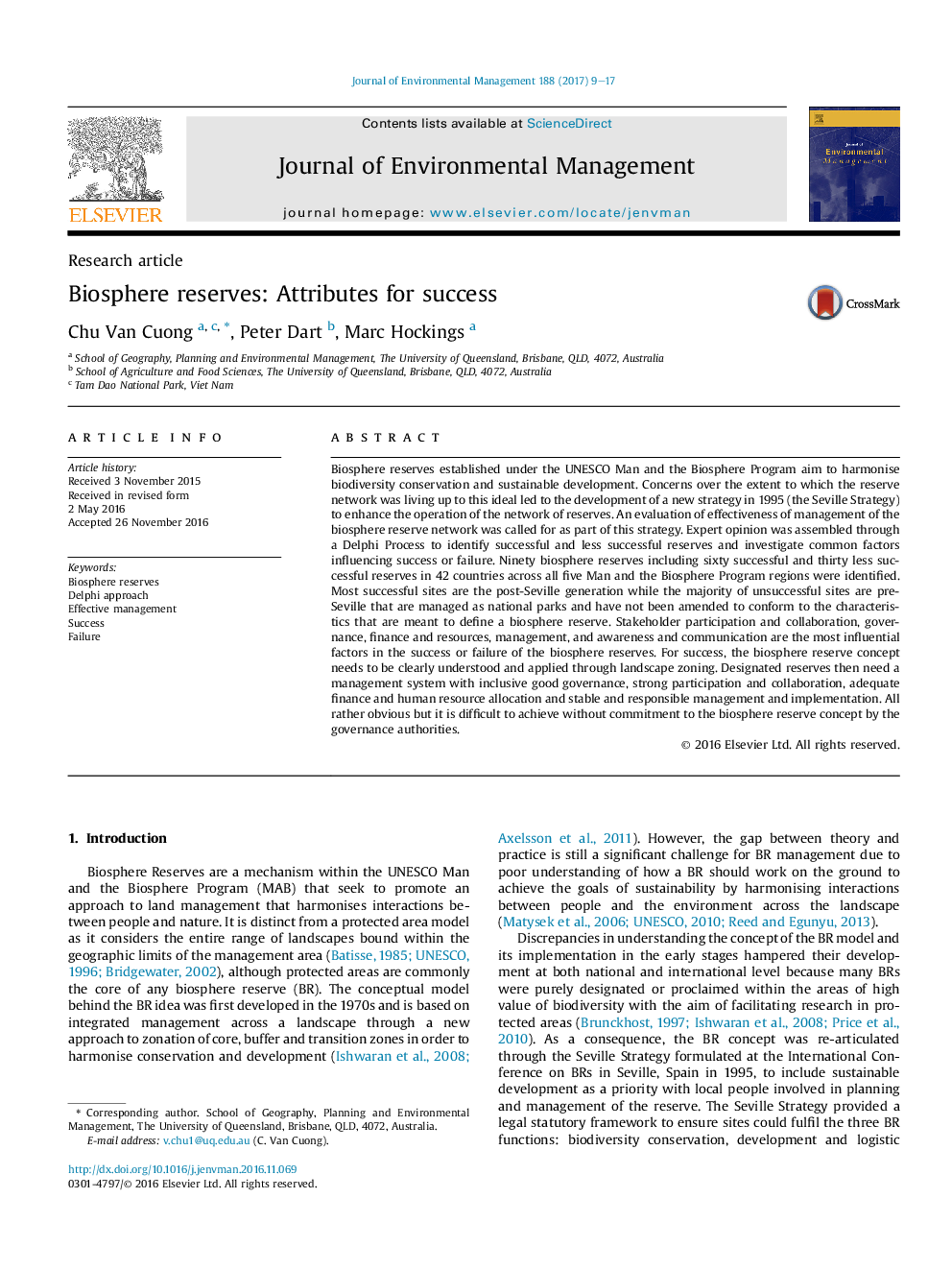| کد مقاله | کد نشریه | سال انتشار | مقاله انگلیسی | نسخه تمام متن |
|---|---|---|---|---|
| 5117118 | 1485227 | 2017 | 9 صفحه PDF | دانلود رایگان |
عنوان انگلیسی مقاله ISI
Biosphere reserves: Attributes for success
ترجمه فارسی عنوان
ذخایر بیوسفر: ویژگی های موفقیت
دانلود مقاله + سفارش ترجمه
دانلود مقاله ISI انگلیسی
رایگان برای ایرانیان
کلمات کلیدی
ذخایر بیوسفر رویکرد دلفی، مدیریت موثر، موفقیت شکست،
ترجمه چکیده
ذخایر بیوسفر که تحت برنامه یونسکو و برنامه بیوسفر ایجاد شده است، هدف هماهنگ سازی حفاظت از تنوع زیستی و توسعه پایدار است. نگرانی نسبت به اینکه شبکه رزرو برای این ایده زندگی می کرد، منجر به توسعه یک استراتژی جدید در سال 1995 (استراتژی سویل) برای افزایش عملکرد شبکه ای از ذخایر شد. به عنوان بخشی از این استراتژی، ارزیابی اثربخشی مدیریت شبکه ذخیره ذخایر بیوسفر به شمار می رود. نظر کارشناسان از طریق یک فرآیند دلفی برای شناسایی ذخایر موفقیتآمیز و کمتر موفق، و بررسی عوامل مشترک بر موفقیت یا شکست، جمعآوری شد. نهصد ذخایر بوسفروش از جمله 60 موفق و 30 ذخایر موفق کمتر در 42 کشور در سراسر پنج منطقه مناطق انسان و منطقه بیوسفر مشخص شده است. بیشترین سایت های موفق، نسل بعد از سویا هستند، در حالی که اکثر سایت های ناموفق قبل از سوییل هستند که به عنوان پارک های ملی اداره می شوند و اصلا اصلاح نشده اند تا ویژگی هایی را که برای تعریف ذخایر بیوسفر وجود دارد، اصلاح کنند. مشارکت و همکاری متقابل، حکومتداری، مالی و منابع، مدیریت و آگاهی و ارتباطات، عوامل تاثیرگذار در موفقیت یا شکست در ذخایر بیوسفر هستند. برای موفقیت، مفهوم ذخیره ذخایر بیوسفر باید به وضوح از طریق پهنه بندی چشم انداز به کار گرفته شود. ذخایر تعیین شده پس از آن نیاز به یک سیستم مدیریت با مدیریت جامع جامع، مشارکت و همکاری قوی، تخصیص منابع مالی مناسب و منابع انسانی و مدیریت و پیاده سازی پایدار و مسئول. همه چیز واضح است، اما بدون تعهد به مفهوم رزرو ذخایر بیوسفر توسط مقامات حکومتی دشوار است.
موضوعات مرتبط
مهندسی و علوم پایه
مهندسی انرژی
انرژی های تجدید پذیر، توسعه پایدار و محیط زیست
چکیده انگلیسی
Biosphere reserves established under the UNESCO Man and the Biosphere Program aim to harmonise biodiversity conservation and sustainable development. Concerns over the extent to which the reserve network was living up to this ideal led to the development of a new strategy in 1995 (the Seville Strategy) to enhance the operation of the network of reserves. An evaluation of effectiveness of management of the biosphere reserve network was called for as part of this strategy. Expert opinion was assembled through a Delphi Process to identify successful and less successful reserves and investigate common factors influencing success or failure. Ninety biosphere reserves including sixty successful and thirty less successful reserves in 42 countries across all five Man and the Biosphere Program regions were identified. Most successful sites are the post-Seville generation while the majority of unsuccessful sites are pre-Seville that are managed as national parks and have not been amended to conform to the characteristics that are meant to define a biosphere reserve. Stakeholder participation and collaboration, governance, finance and resources, management, and awareness and communication are the most influential factors in the success or failure of the biosphere reserves. For success, the biosphere reserve concept needs to be clearly understood and applied through landscape zoning. Designated reserves then need a management system with inclusive good governance, strong participation and collaboration, adequate finance and human resource allocation and stable and responsible management and implementation. All rather obvious but it is difficult to achieve without commitment to the biosphere reserve concept by the governance authorities.
ناشر
Database: Elsevier - ScienceDirect (ساینس دایرکت)
Journal: Journal of Environmental Management - Volume 188, 1 March 2017, Pages 9-17
Journal: Journal of Environmental Management - Volume 188, 1 March 2017, Pages 9-17
نویسندگان
Chu Van Cuong, Peter Dart, Marc Hockings,
